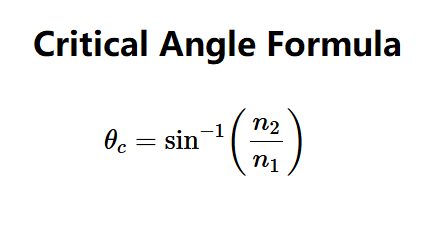 Home
Home
 Back
Back

Definition: The critical angle is the angle of incidence at which the angle of refraction becomes 90 degrees, leading to total internal reflection, calculated using the formula:
Variables:
Details: The critical angle is fundamental in optics, particularly in applications like optical fibers, prisms, and endoscopes, where total internal reflection is used to guide light efficiently.
Tips: Enter the refractive indices of the two media. Ensure \( n_1 > n_2 \) (light must travel from a denser to a less dense medium). Click "Calculate" to get the critical angle in both degrees and radians.
Q1: What is the critical angle?
A: The critical angle is the angle of incidence at which the angle of refraction is 90 degrees, leading to total internal reflection.
Q2: What is total internal reflection?
A: Total internal reflection occurs when light traveling from a denser to a less dense medium exceeds the critical angle, reflecting entirely within the denser medium.
Q3: What is the refractive index?
A: The refractive index (\( n \)) is a dimensionless number that describes how much light slows down and bends in a medium compared to a vacuum.
Q4: Why must \( n_1 \) be greater than \( n_2 \)?
A: Total internal reflection only occurs when light travels from a denser medium (\( n_1 \)) to a less dense medium (\( n_2 \)), ensuring \( \sin(\theta_c) \leq 1 \).
Q5: How accurate is this calculator?
A: The calculator is accurate based on Snell's Law and the input values, assuming ideal conditions. Real-world factors like dispersion or surface imperfections may introduce variations.